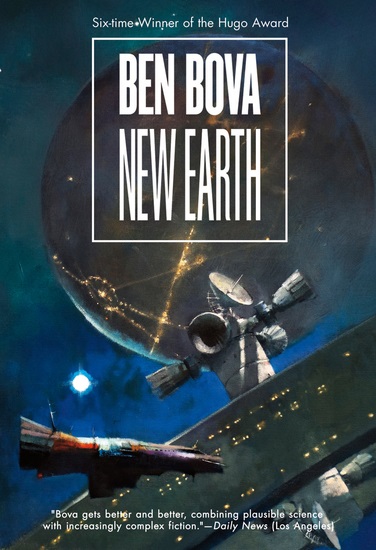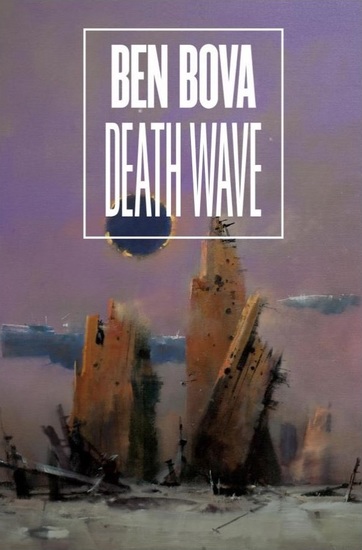Future Treasures: Apes and Angels, the Newest Volume in the Star Quest Trilogy by Ben Bova
 |
 |
 |
When I was a teenager in Ottawa I attended the local SF convention, Maplecon, a marvelous con that I still miss today, without fail every year. In 1984 I was a volunteer, and I was assigned as the liaison for our Guest of Honor, author and editor Ben Bova. I picked Ben and his wife up from the airport and drove them around town, and got to know them pretty well. Ben was gracious, kind, and a marvelous conversationalist, and we talked about everything — various ways to express the laws of thermodynamics, the re-election of Ronald Reagan, his time as editor of Analog, and lots more. In fact, Ben was one of the first industry professionals I got to know personally, and he made a big impression on me.
As a writer, he’s been amazingly prolific over the past few decades, releasing 22 books in his Grand Tour SF series, which explore the solar system, as well as his Voyager series, his Sam Gunn stories, six novels in the Orion sequence, and nearly two dozen standalone novels and collections. His current project is the Star Quest Trilogy (part of the Grand Tour), which takes the series outside the solar system for the first time. New Earth (2013) sets the stage for the trilogy, which began with Death Wave (2015), and continues with Apes and Angels, arriving in hardcover from Tor Books at the end of this month.
All three novels were published by Tor Books, with covers by John Harris.
New Earth (384 pages, $25.99 hardcover, $7.99 paperback, $8.99 digital; July 16, 2013)
Death Wave (384 pages, $25.99 hardcover, $7.99 paperback, $8.99 digital; November 17, 2015)
Apes and Angels (384 pages, $25.99 hardcover, $12.99 digital; November 22, 2016)
New Earth, which is sometimes listed as part of the Star Quest Trilogy, shares its central character, Jordan Kell. Here’s the description.
The entire world is thrilled by the discovery of a new Earthlike planet. Advance imaging shows that the planet has oceans of liquid water and a breathable oxygen-rich atmosphere. Eager to gain more information, a human exploration team is soon dispatched to explore the planet, now nicknamed New Earth.
All of the explorers understand that they are essentially on a one-way mission. The trip takes eighty years each way, so even if they are able to get back to Earth, nearly 200 years will have elapsed. They will have aged only a dozen years thanks to cryonic suspension, but their friends and family will be gone and the very society that they once knew will have changed beyond recognition. The explorers are going into exile, and they know it. They are on this mission not because they were the best available, but because they were expendable.
Upon landing on the planet they discover something unexpected: New Earth is inhabited by a small group of intelligent creatures who look very much like human beings.
Who are these people? Are they native to this world, or invaders from elsewhere?
While they may seem inordinately friendly to the human explorers, what are their real motivations? What do they want?
Moreover, the scientists begin to realize that this planet cannot possibly be natural. They face a startling and nearly unthinkable question: Could New Earth be an artifact?
Most sources seem to agree that the trilogy officially began with Death Wave (warning: this description has spoilers for New Earth!).
Six-time Hugo Award winner Ben Bova chronicles the saga of humankind’s expansion beyond the solar system in Death Wave
In the precursor to the Star Quest Trilogy, New Earth, Jordan Kell led the first human mission beyond the solar system. They discovered the ruins of an ancient alien civilization. But one alien AI survived, and it revealed to Jordan Kell that an explosion in the black hole at the heart of the Milky Way galaxy has created a wave of deadly radiation, expanding out from the core toward Earth. Unless the human race acts to save itself, all life on Earth will be wiped out.
When Kell and his team return to Earth, many years after their departure, they find that their world has changed almost beyond recognition. Not only has a second wave of greenhouse flooding caused sea levels to rise, but society has been changed by the consequences of the climate shift. Few people want to face Jordan Kell’s news. He must convince Earth’s new rulers that the human race is in danger of extinction unless it acts to forestall the death wave coming from the galaxy’s heart.
The second volume, Apes & Angels, arrives this month.
Humankind headed out to the stars not for conquest, nor exploration, nor even for curiosity. Humans went to the stars in a desperate crusade to save intelligent life wherever they found it.
A wave of death is spreading through the Milky Way galaxy, an expanding sphere of lethal gamma radiation that erupted from the galaxy’s core twenty-eight thousand years ago and now is approaching Earth’s vicinity at the speed of light. Every world it touched was wiped clean of all life. But it’s possible to protect a planet from gamma radiation. Earth is safe.
Now, guided by the ancient intelligent machines called the Predecessors, men and women from Earth seek out those precious, rare worlds that harbor intelligent species, determined to save them from the doom that is hurtling toward them.
The crew of the Odysseus has arrived at Mithra Gamma, the third planet of the star Mithra, to protect the stone-age inhabitants from the Death Wave. But they’ll also have to protect themselves.
See all our recent coverage of the best in upcoming fantasy and SF here.